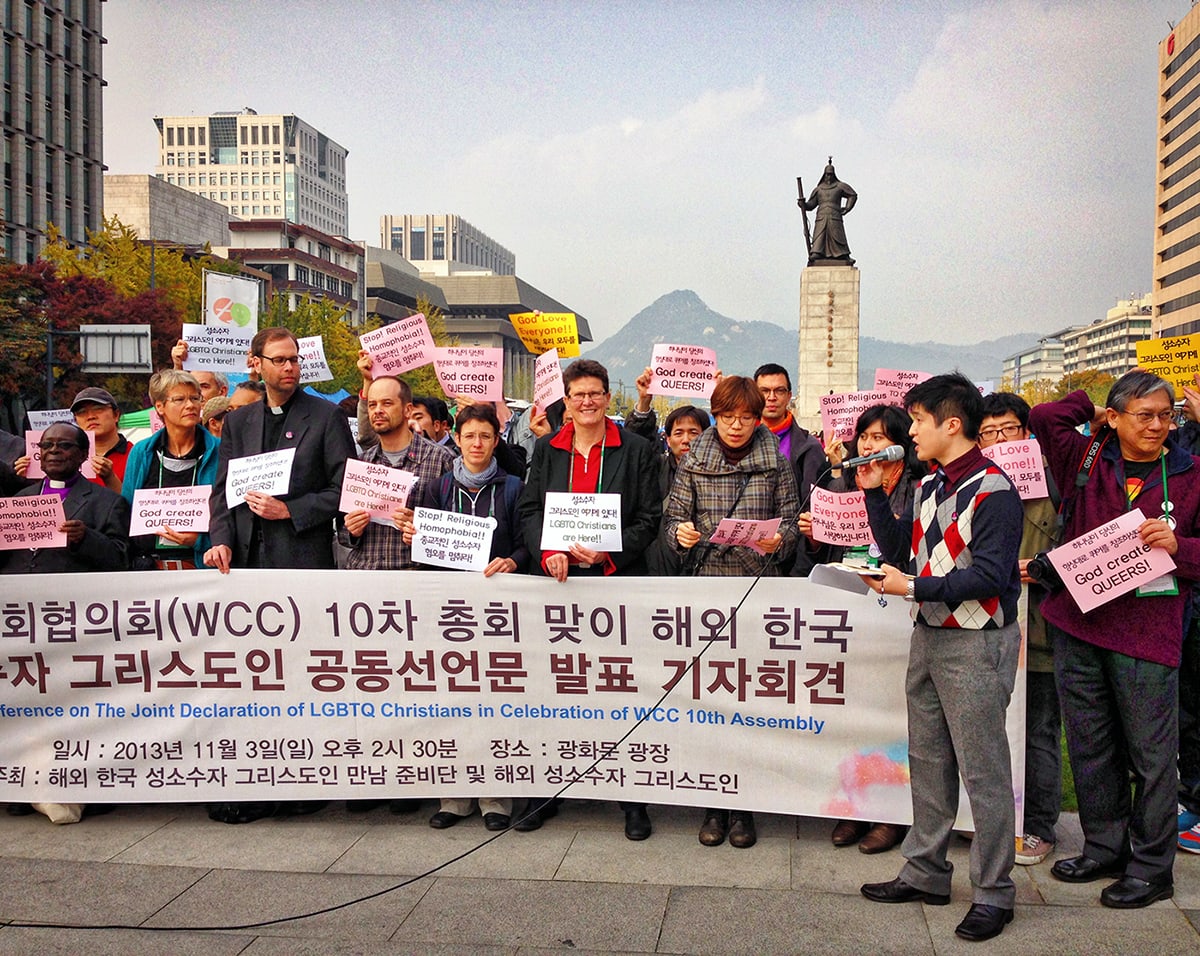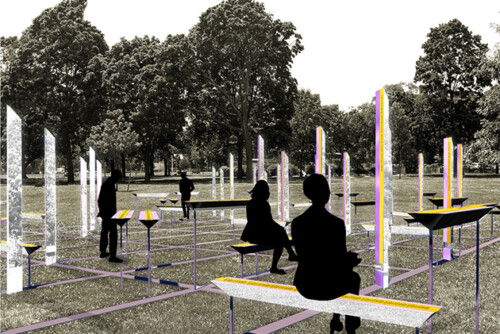Evangelical Geopolitics
The emergence of faith-based queer activism in South Korea has taken place alongside remarkable intensification of organized forms of religious and political homophobia led almost entirely by conservative Christian groups.1 This is not surprising. Lauded by the global evangelical organization Lausanne Committee for World Evangelization as “one of the most theologically conservative in Asia and the world,” the South Korean Protestant church today wields considerable power as a self-proclaimed representative of the moral majority.2 At the WCC assembly in 2013, which was held in the southern port city of Busan approximately 200 miles from Seoul, thousands of conservative Protestants had gathered outside the Busan Exhibition and Convention Center (BEXCO) in what was described as the most “well-organized and vehement opposition” against the ecumenical WCC since its founding in 1948.3 Singing spirited hymns and shouting “Down with the WCC!” to protest against what they decried as WCC’s liberal theology and “un-Christian” tolerance of Communism, religious syncretism, and so-called promotion of homosexuality, the evangelical protesters shouted forceful prayers over loudspeakers and distributed propaganda leaflets that equated tolerance of homosexuality with Satan’s two-pronged crusade against Christianity and national security of South Korea.4
The evangelical opposition to the WCC Assembly had been brewing for months. In March 2013, a group called The People’s Voice Against the WCC Assembly in Busan had petitioned the South Korean Ministry of Culture, Sports and Tourism to deny state funding support for the WCC, claiming that hosting the WCC assembly was “no different from providing food, car, and room to accommodate North Korean special forces in South Korean military camouflage.”5 Such militaristic security references are common among Protestants engaged in spiritual warfare.6 A joint statement against the WCC declared that as South Korean Christians, they stood militantly against “Communism, humanism, homosexuality, and all ideologies counter to the Gospel.”7
The spectacle of the conservative evangelical protests frustrated progressive and liberal Christians and dismayed LGBTQ delegates who saw the WCC hardly as a bastion of radicalism or a safe haven for homosexuality but itself a contested terrain of ongoing struggle over such issues as abortion, homosexuality, and the place of women within the Christian church. Many had in fact been actively challenging the reluctance of the WCC leadership to take a stance either for or against homosexuality and same-sex unions. Before they had to defend the WCC against the evangelical attacks, a coalition led by the Christian Solidarity for a World Without Discrimination and Rainbow Action Against Sexual Minority Discrimination, along with fifteen other groups and individual Protestant leaders, had petitioned the WCC urging queer-inclusive policies. Heleen de Boer, then co-president of the European Forum of Lesbian Gay Bisexual and Transgender Christians, told Ecumenical News, “We are angry and disappointed at the position taken by the WCC on this issue. People are being persecuted, beaten and sometimes killed in Africa and other places and now we hear the WCC has no policy on support for homosexuals.”8 Facing resistance within the ecumenical WCC and surrounded by spectacular hostility of conservative evangelicals outside the WCC, LGBTQ-identified Christian activists and allies across denominations—Anglicans, Catholics, Baptists, Methodists, and Presbyterians—were struggling simultaneously with both evangelicals and ecumenicals over the issues of minority citizenship.
Queer cultural and activist spaces have no doubt gained visibility and recognition in recent decades in Korea, as evidenced by the nearly twenty years of annual queer film festivals and ever-growing LGBTQ pride events and queer visibility in the social movement landscape and critical scholarship. However, the infrastructure of religious homophobia has likewise grown, led by the well-endowed and powerful national umbrella group Christian Council of Korea (CCK). Best known by its Korean acronym Han’gich’ong, CCK is supported by theologically and politically conservative megachurches with tremendous financial power and mobilization capacity. In addition, a constellation of small but extremely vocal conservative Christian advocacy groups against homosexuality—who are especially incensed these days by the idea of same-sex marriage—have built a platform of political homophobia. Korean Citizens’ Alliance for a Healthy Society (Kŏnsayŏn) regularly disseminates misinformation about HIV/AIDS; Jesus Foundation (Yesu Chaedan) led by a self-described ex-gay pastor actively promotes gay conversion programs; Esther Prayer Movement opposes homosexuality along with abortion and stem cell research; and a group called the Holy City Movement seeks to expel queers from the city in order to create “a holy and decent city in which families can live without moral decline, violence and crime.”9 In their geographical imaginary, the city is not a destination for sexual liberation and political empowerment. Just as the family operates as a key site for ensuring normative heteropatriarchal reproduction, the city to them figures as an important basic geopolitical unit for securitizing national territory. Homosexuality is perceived as a threat to their evangelical geopolitics.
Same Square, Different Layers
The international LGBTQ Christian gathering in celebration of the WCC Assembly concluded with a press conference held in Seoul’s city center at Gwanghwamun Square. Most passersby appeared indifferent, but some curious onlookers did stop to watch and whisper—“Look, foreigners!” said a couple of teenage girls as they walked by. The delegates read aloud the 2013 Declaration of Sexual Minorities in South Korea and Supportive Overseas Partners first in Korean, then in English, to a small group of reporters and photographers. This was a newsworthy moment of international solidarity for LGBTQ Christians and an expression of Christians for LGBTQ equality.

Behind the banner in the photo above, one can clearly see the statue standing tall. It is ironic that one of the most photographed locations for protest declarations prominently features the imposing statue of Admiral Yi Sun-shin in the background. A landmark statue installed in 1968 by former President Park Chung Hee—who had obvious reasons during his 18-year military dictatorship to advance a military figure as a key historical national hero—it stands as an anomalous veneration of a military figure in a society traditionally known for Confucian respect for scholars and writers and general contempt for soldiers and merchants. Today, Park’s authoritarian legacy looms larger than ever as his daughter Park Geun-Hye occupies the Presidency. She faces ongoing criticism for recruiting her father’s old henchmen into her ultra-conservative Cabinet and unleashing state intelligence agencies and the ever-useful National Security Law to suppress political dissent. The very location where the LGBTQ Christian press conference took place has seen countless demonstrations and protest rallies against her government and policies. Just moments before the LGBTQ Christian press conference, another contingent had unfurled their banner for the press at the exact same spot, demanding political transparency and greater democracy. And after the LGBTQ press conference, another group waited their turn to set up.
Across the square, not far from the press conference, was a long-term protest encampment guarding a memorial shrine for twenty-three deceased Ssangyong Motors auto workers. Catholic clergy and parishioners held a nightly street mass there for 225 consecutive days in 2013.10 No one of course knew in 2013 what the future held. The tragic sinking of the Sewol ferry just a few months later on April 16, 2014 meant the city centre would soon be covered in commemorative yellow ribbons, and before long, another long-term protest encampment was set up—still ongoing in September 2016—by the grieving families who continue to this day to demand answers and public accountability for the lives lost on the Sewol. At a labor rally in November 2015, a 69-year-old farmer and long-time Catholic activist was blasted in the face at close range by a high-velocity police water cannon and has since been in a coma. In the summers of 2015 and 2016, the annual Queer Culture Festival celebrated record turnout at the same location where countless protest rallies and violent police repression have routinely taken place. And public assembly is not always left or progressive—at the very site where the Catholic solidarity mass commemorated the death of Ssangyong auto workers, Christian conservatives staged anti-LGBTQ counter-protests outside the Queer Culture Festival. These are just a few of the multiple layers of political engagement and public demonstrations in the city. The LGBTQ Christian declaration was but one articulation of alliances, affinities, and aversions old and new.
Postscript, December 5, 2016
Nam-ki Baek, the farmer who was struck by police water cannon in November 2015, passed away on September 25, 2016. His death prompted a series of protests, public mourning, and acts of civil disobedience that erupted into mass protests in Seoul in November 2016. The Gwanghwamun Square and the Admiral Yi Sun-shin statue mentioned in this essay have been the very center of unprecedented public assembly.
This paper is based in part on research supported by an Academy of Korean Studies Grant funded by the Korean Government (MEST) (AKS-2011-AAA-2104).
- Ju Hui Judy Han, “The Politics of Homophobia in South Korea,” East Asia Forum Quarterly 8.2 (April–June, 2016): 6-7; Ch’ae-yun Han, “Wae Han’guk Kaeshinkyonŭn ‘Tongsŏng’ae’rŭl Chŭng’ohanŭn’ga? [Why does Korean Protestantism despise homosexuality?],” Inmulkwa Sasang 213 (January 2016): 114–27. [↩]
- Bong Rin Ro, “WCC General Assembly Aftermath: Overcoming Korean Church Divisions and Encouraging Cooperation Among Evangelicals Globally,” The Lausanne Movement (April 25, 2014). Accessed February 28, 2015. [↩]
- Ro, “WCC General Assembly Aftermath,” 2014. [↩]
- My translation from Korean. Yong-p’il Yi. “WCC bandae danch’e, ‘chŏngbu WCC chiwonkŭm jikŭp malla’ [Group against ACC, ‘no government funding support for WCC’],” News N Joy, April 3, 2013. [↩]
- My translation from Korean. Yong-p’il Yi. “Tongsŏng’ae tullŏssan WCC 10 ch’a ch’onghoe anp’akŭi p’ung’gyŏng” [Scenes surrounding homosexuality inside and outside the 10th General Assembly of the WCC],” News N Joy, November 6, 2013. Accessed November 7, 2013. [↩]
- Also see Elizabeth McAlister, “The Militarization of Prayer in America: White and Native American Spiritual Warfare,” Journal of Religious and Political Practice 2.1 (January 2, 2016): 114–30. [↩]
- Quoted in Bo-ra Im. “WCC-ŭi Sŏngsosujae Daehan Kyŏnhaewa Hyanghu Chŏnmang [WCC perspectives and prospects concerning sexual minorities],” Kidokkyo Sasang [Christian Thought] 657 (September 2013): 57. [↩]
- Trevor Grundy, “Gay Group Upset About Churches Group ‘Dodging’ Homosexuality,” Ecumenical News, November 3, 2013. [↩]
- Holy City Movement, accessed December 12, 2014. [↩]
- The 225th and final street mass was held on November 20, 2013. See YouTube video documentation. [↩]



